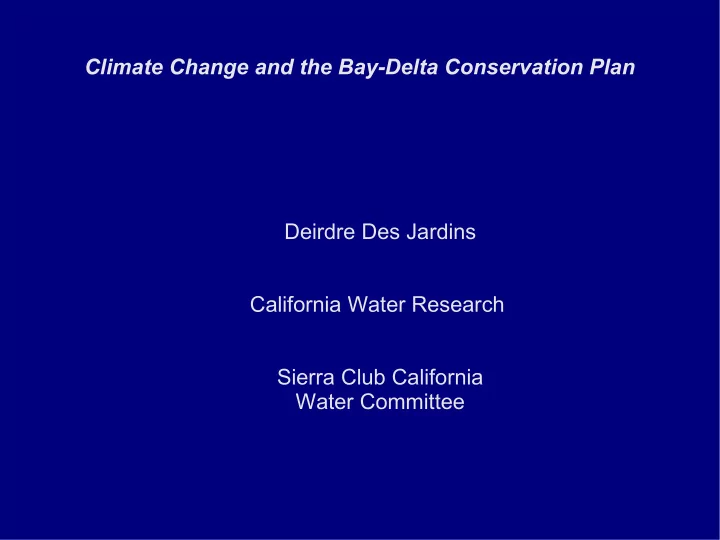

Climate Change and the Bay-Delta Conservation Plan Deirdre Des Jardins California Water Research Sierra Club California Water Committee
Recent drought in Southwest ➲ 2011-12: 500-1000 year drought in Texas ➲ 2012-13: 500-1000 year drought in New Mexico ➲ 2013-14: 500 year drought in California
Drought and Climate Change ➲ Many climate change models predict significant drying in Southwest & Sierra Nevada mountains by mid-century ➲ Huge risk of increase in frequency and severity of droughts NOAA snowpack Jan 2014 ➲
Drier Climate Change Models ➲ Example: US Geological Survey, California Water Science Center, Randy Hanson et. al. 2012 ➲ Global Fluid Dynamics Lab GCM model (used in 2006, 2009, & 2012 California Climate Adaptation Strategy modelling) ➲ A2 greenhouse gas scenario (medium-high emissions) ➲ Forecasts 17% reduction in Sacramento River flows by 2030 and 34% by 2080 R.T. Hanson, L. E. Flint, A. L. Flint, et. al., , A method for physically based model ➲ analysis of conjunctive use in response to potential climate changes, Water Re- sources Research, v. 48
Projected reduction in Sacramento River flows (R. Hanson et. al. 2012)
Change in frequency of wet & dry years (R. Hanson et. al. 2012)
California Climate Change Adaptation Strategy climate models predict significant drying Sarah Null and Josh Viers, UC Davis, 2012 ➲ Six Global Climate models used for the state of California 2012 Climate Change Adaptation Strategy modelling, two GHG sce- narios (low & medium-high) ➲ All 12 projections showed a significant increase in dry and criti- cally dry years by the end of the century ➲ Almost all models also showed significant decrease in wet years Sarah Null and Josh Viers, Water and Energy Sector Vulnerability to Climate Warming in the Sierra Nevada: Water Year Classification in Non-Stationary Climates, CEC White Pa- per, July 2012.
Decrease in wet years and increase in dry & critically dry years for almost all models by midcentury (Null & Viers 2012)
Change in Wet & Dry years averaged over all 6 GCM models (Null & Viers 2012)
Bay Delta Conservation Plan climate change modelling ➲ Uses projections from 115 Global Climate Model / Greenhouse Gas Emissions scenario combinations (Lawrence Livermore National Lab) ➲ Classifies 115 GCM / scenario climate projections into “more warming, less warming” and “more drying, less drying” ➲ Forecasts 13-15% reduction in Sacramento River flows under drier scenarios
BDCP classification: 115 GCM / scenarios ➲ Q1: Drier, less warming ➲ Q2: Drier, morewarming ➲ Q3: Wetter, more warming ➲ Q4: Wetter, less warming
BDCP ensemble models: Feather River
BDCP forecast change in inflow to reservoirs
BDCP wetter & drier climate change forecasts not published ➲ Only released internally to BDCP Steering Committee ➲ Not included in any of BDCP EIR drafts ➲ Not discussed at any BDCP public meetings
What does BDCP EIR use for water delivery forecasts? ➲ “Central Tendency” projection ➲ Throws out 50% of drier models and 50% of wetter models, then averages projections of remaining models ➲ Essentially assumes wetter & drier futures equally likely ➲ Disguises risk to water deliveries
Example: Feather River flows
BDCP & Reservoirs ➲ BDCP relies on South Delta pumps in dry years ➲ BDCP EIR water delivery forecasts assume draining Shasta, Trinity, & Folsom reservoirs to minimum pool to meet export targets
Shasta reservoir repeatedly drained to minimum pool in repeat of 87-92 drought
BDCP & Sea Level Rise ➲ BDCP EIR does not model performance of tunnels under high levels of sea level rise ➲ EIR uses value of 18 inches for sea level rise ➲ Even with tunnels, salinity intrusion could drastically curtail ex- ports by 2100 ➲ Tunnels may at best be a short term solution
US Army Corps of Engineers Modelling 1.68 m sea level rise (high value for 2100)
We can do better ➲ For the Sacramento Delta and San Francisco Bay ➲ For salmon and pelagic fish in the Delta ➲ For migrating birds
Sierra Club Alternative ➲ Accept peak water and environmental limits ➲ Reduce risk to economy and environment by investing in local water efficiency and water reuse ➲ Focus on sustainability and environmental stewardship ➲ New growth needs to come from reductions elsewhere ➲ Most cost-effective and least energy-intensive alternative
Urban Water Conservation ➲ Big savings could be achieved by replacing thirsty lawns and plantings with low-water landscape, installing smart irrigation technology, and utilizing rainwater and greywater ➲ More consumer education campaigns and aggressive rebate programs for more efficient appliances
Major Investments in Repairs ➲ About 10% of urban water is lost through leaks in aging distri- bution infrastructure, wasting energy as well as precious sup- plies ➲ New technology allows more efficient location and repair of leaks
Water meters, detailed usage reports and tiered rates ➲ Tiered water rates, drought rates, and home usage reports give customers detailed feedback and an incentive to conserve ➲ Eliminate fixed rates for all large landscapes, expand meters to all dwellings in state ➲ Use separate meters in multi-family housing and separate me- ters for landscaping to increase data and billing options
Urban water recycling ➲ In 2009, DWR estimated that recycling municipal wastewater could save up to 2.3 million acre-feet ➲ Some California cities already use recycled water for aquifer recharge, which helps make the strategy more affordable and less resource intensive
Agricultural water efficiency ➲ Agriculture uses 75 percent of California’s water ➲ Agricultural conservation strategies—including weather-based irrigation controllers, drip irrigation and climate-appropriate crop selection—could yield over 3.4 million acre-feet in water sav- ings
Managing groundwater sustainably ➲ California is one of the few states in the nation that does not regulate groundwater ➲ Failure to coordinate and moderate groundwater use has led to unsustainable levels of overdraft
For More Information ➲ The entire text of Sierra Club California’s Sustainable Al- ternatives policy paper can be accessed online: http://california2.sierraclub.org ➲ California Water Research http://h20research.com/
Recommend
More recommend